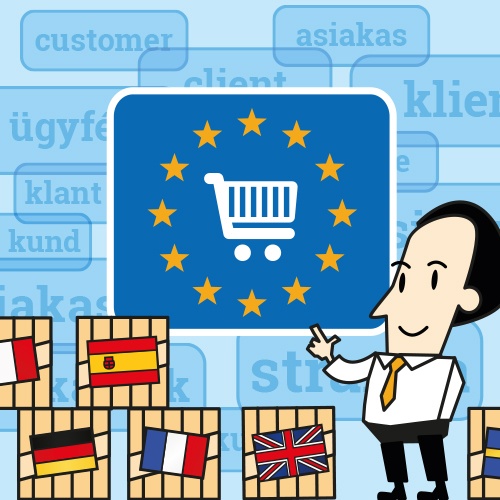Did you miss it?
Walking around any place in the UK it is hard not to see someone looking at their smartphone, therefore it is not surprising that the UK’s Ofcom(1) report out in August 2015 heralding in the official status that the UK is a “Smartphone society” went largely unnoticed. So if you missed it (buried in the depths of a 435 page report) here it is… “For the first time, the smartphone has overtaken the laptop as the device internet users say is the most important for connecting to the internet; in 2015 33% chose their smartphone…” and there is even a funky graph to go with it.
Read More
Tags:
All posts,
Global Markets
The UK and the USA are among each other’s top export markets.The USA is the largest single destination for British exports, and the UK is America’s largest export market in the EU (#5 overall). UK <=> US trade alone equals $214 billion a year.
Many of our clients with an American/British English website ask whether it’s really necessary to build a country specific website for the UK/US markets given the language similarity. Ideally - yes, you should build a country specific website for each of your geographical markets, but it is of a lesser urgency than building a website for let’s say a German/French market that speaks a completely different language.
Read More
Tags:
All posts,
Global Markets

Many EU standards and policies that facilitate business and trade have been developed over the past years. However, the EU is yet to become a truly single market. Local small-medium sized companies face barriers when selling online, so do US exporters. Europe must embrace the digital revolution and open up digital opportunities for people and businesses. The European Commission believes that using the power of the EU's Digital Single Market will allow Europe to achieve this goal. This May, the European Commission introduced its detailed plans to create a Digital Single Market with the objective to combat its current online barriers in order to boost EU-wide cross-country e-commerce. This will help start-ups and small-medium sized companies to fully benefit from growth opportunities of the EU market. Subsequently, this will also allow US companies export more easily across the EU from a single central location. Country-specific regulation has been identified as the greatest barrier to a single, fully functional e-commerce market.
Read More
Tags:
All posts,
Global Markets,
Global Ecommerce
If you want to be visible in your target export market online, you need to optimize your website for local search engines, such as google.de in Germany or google.fr in France. You might laugh that we call this global search engine giant local, but that is indeed the truth. Over 90% of searches in most European countries come from local Googles that show different search results. Remember, you cannot simply translate a well performing US keyword to Spanish or Dutch and expect to see the same results. Search trends, including keywords popularity and difficulty to rank, vary among markets.
Read More
Tags:
All posts,
Global Markets,
International Online Marketing
How many languages can you speak sufficiently well to communicate with your fellow humans? Today's hyper-connected world enjoys approximately 6,500 languages, shared amongst >7 Bn people spread across >169 countries. So how do you feel now? Belittled? I do. Language, and communication between differing languages, is an issue that humankind has faced for a wee while now. Now, where did all these languages come from?
Read More
Tags:
All posts,
Global Markets
We bring you 5 trends that have become crucial for any company that wishes to succeed in Europe and stay ahead of their competition. Don't lag behind! Read our tips on: design - responsive, flat with subtle animation, user-friendly and online marketing - videos and multilingual marketing on social media.
Read More
Tags:
All posts,
Global Markets,
International Online Marketing
Living in the USA, browsing with Google.com, your search results are invariably in English. If you search for a product then Google tells you where to find it locally. The internet is mostly in English, right?
Read More
Tags:
All posts,
Global Markets
We all know Bruce Springsteen’s view on getting paid. Clearly, the European Payments Council (EPC), the decision-making and coordination body of the European banking industry in relation to payments, charged with developing the Single Euro Payments Area (SEPA), had the Boss in mind, when scoping out this innovative program.
Read More
Tags:
All posts,
Global Markets,
Global Ecommerce
Every year, the European Union's (EU) 28 countries import 100’s of billions of dollars worth of goods and services from the USA. This year, the figure is expected to be >$0.5 Tn. In 2013, the USA and the EU remained, and have always been, each other’s largest export/import (>$1 Tn annual flow) and investor partners (>$300 Bn annual flow). This is not a new situation, the transatlantic relationship is key for US exporters, and is not one that is likely to change in the near future.
Read More
Tags:
All posts,
Global Markets
"The Single Market is the European Unions’ grown jewel, and online is its natural new home. So let’s bring down those barriers”, announced Neelie Kroes (Vice President of the European Commission responsible for the Digital Agenda for Europe) in June 2014, preceding the Global Ecommerce Summit in Barcelona, Spain.
Read More
Tags:
All posts,
Global Markets










